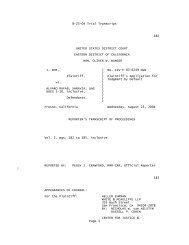Romero_Trial_Transcript_8_25_04_53_2
You also want an ePaper? Increase the reach of your titles
YUMPU automatically turns print PDFs into web optimized ePapers that Google loves.
8-<strong>25</strong>-<strong>04</strong> <strong>Trial</strong> <strong>Transcript</strong><br />
16 THE COURT: This is as of March of 1980.<br />
17 THE WITNESS: At that time, the first people to<br />
18 arrive were the National Police. Then the police would<br />
19 notify, in case of a death, they would notify the forensic<br />
20 clinic of the courts.<br />
21 BY MR. EISENBRANDT:<br />
22 Q. When would the criminal judge arrive?<br />
23 A. A criminal judge arrives when he is notified that there is<br />
24 a body. But at that time, he has to wait to be notified, and<br />
<strong>25</strong> it's either him that's notified or the justice of the peace.<br />
RAMIREZ AMAYA - D<br />
208<br />
1 Q. Am I correct that you have been both a justice of the<br />
2 peace and a criminal judge?<br />
3 A. Yes.<br />
4 Q. In the case that you have described normally, when a<br />
5 justice of the peace is involved, when would the justice of<br />
6 the peace arrive?<br />
7 A. Not until he's notified by the police.<br />
8 Q. In a normal investigation, who would take fingerprints?<br />
9 A. The police does.<br />
10 Q. Who would take photos of the crime scene?<br />
11 A. The police does.<br />
12 Q. Who would take down names of witnesses?<br />
13 A. The police.<br />
14 Q. Could the police remove evidence from the scene on their<br />
15 own?<br />
16 A. No. They are taken by the judge and the judge gives them<br />
17 to the police.<br />
18 Q. Just to be clear, normally, after the police inform the<br />
Page 23





